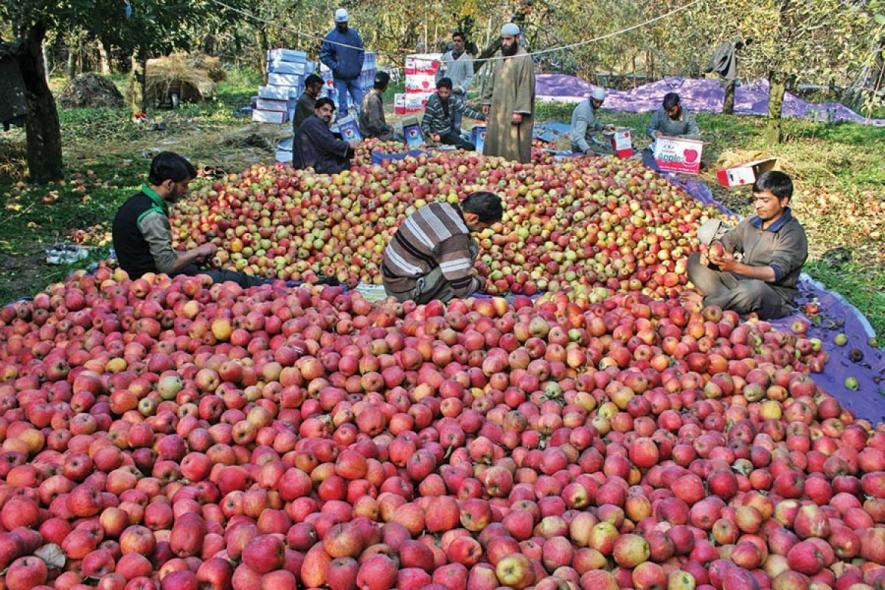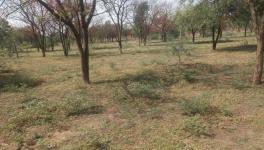Artificial Intelligence-Linked Apple Production a Major Disruptor in Himachal

File Photo
Apple production is a significant part of Himachal Pradesh's economy and livelihoods. Recent developments in science, technology and germination are transforming this vital sector significantly. The state is second in apple production in India, with apples comprising 85% of total fruit production and nearly 48.8% of the total area under fruits.
The total area producing apples and cumulative yield presents an exciting picture of ‘mass horticulture production’. Since 1950-51, from just 500 hectares of land, apple production covered 5,025 hectares in 1960-61, and by 2021-22, the nearly 1,15,016-hectare area was under the fruit’s production. Thanks to the efforts of the hill state’s founding Chief Minister, Yashwant Singh Parmar, this journey was propelled to such heights.
Major Shift in Cropping Patterns and Varieties
We have, in these columns, explained the crisis that the apple crop is facing in the state and the massive unrest it has created amongst the apple farmers. The significant issues of the unrest continue to be the ‘rise in the cost of production’ of the crop and the ‘near spontaneity of the market’ that gives crazy prices to the growers. The big players have already entered the market to buy the apple crop and have influenced the purchase of the apple crop.
Read Also: Himachal: Sky Rocketing Production Costs Push Apple Growers to Protest Against Govt
This unrest was one of the primary reasons for the defeat of the Bharatiya Janata Party (BJP) in Himachal Pradesh in the recent Assembly elections, which could not handle the people’s anger. The current government has tried to reach out to some intermediary agreement in the form of a ‘universal carton’.
However, the changes seen in apple production can be considered a significant disruption in the concept of ‘mass horticulture production’.
This can be explained through a recent visit by this writer to Gumma in the Kotkhai region in the state. A rich peasant there has experimented with new imported varieties of apple from a nursery in Italy.
He has planted 1,500 plants in an area of nearly 4,000 square metres. These plants are different from conventional ones. These are rootstocks, cloned high-density varieties. The difference between the conventional method and these new varieties is that the earlier ones were developed from the seeds and the plants matured in nearly 10-12 years. In contrast, the new rootstock varieties start bearing fruit in three years.
Read Also: HP: Agitation by Apple Growers Intensifies Against Rising Input Costs; Big Protest Planned on Aug 5
The cost of planting 1,500 plants is nearly Rs 30 lakh, and the method of plantation is done in a ‘protected environment’. The cropping method is highly mechanised and digital. Unlike in the past, where plants were planted on hilly slopes or fields, the new ones were laid in relative positions with the base covered by artificial material. This is to ensure that water is conserved and the growth of weeds is checked.
The plant's yield is high, and in the given area, the difference between the conventional and the rootstock is nearly double the production.
Not just Italian; there are Israelis, Americans and Belgians in the market and exploring the possibilities of a large market in the state.
Role of AI
Artificial Intelligence (AI) plays a pivotal role in their production. ‘Fasal’, an AI company based out of Bangalore and having Singapore and Australian companies as investors, is providing the basic architecture of artificial intelligence in mapping the soil moisture, reading the India Meteorological Department (IMD) portal, and even advising the farmer to provide nutrients and water to the plant. The apple grower from Gumma showed the app on which he explained the health of his plants.
So far, all is good. The above mentioned company takes an annual rent of nearly Rs 7,000 and collates all the data. The AI can even go to lengths to integrate this data with some market players, if it wants, and play with the market prices.
The major problem with this cropping pattern and plants, as explained by Professor Vijay Singh, former vice chancellor of a horticulture university, is that these plants cannot survive without continuous water as the roots of the ‘root stock’ plants are very shallow. On average, 10 litres of water per plant per week is required, and drip irrigation is used.
Setback to Mass Production
The high-density variety is making massive inroads in the apple bowl of the state. Wealthy farmers are rapidly shifting to this form of production, where the capital cost of investment varies from Rs 30 lakh to Rs 1 crore, depending upon the size of the farm. Those shifting to this form of production cite examples of China, Europe, the US and other nations where the per-hectare yield is almost five times that of India. They say there is no alternative but to shift to this form of production to match them in the market.
Still, 95 % of apple farmers cannot bear the burden of such a transformation. If they start moving away, there will be a total collapse of the ecosystem in the region. The effects of this transformation would soon start coming, explained Prof Vijay, as most of these growers have started tapping water legally and illegally through boring, which will further disturb the hill state’s ecosystem.
The geographical and environmental variation is also significant and unpredictable. In the current year, in the same apple orchard, one could find ‘zero to fruit’ stages. Unseasonal rains have washed away the flowers and will severely impact apple production in the region. With this variation, it is difficult to ensure a fixed cropping pattern.
This transformation also shows the near failure of government agencies, particularly the extension centres of horticulture universities and the much-touted Pradhan Mantri Krishi Vigyan Kendras. There is hardly any movement in these centres.
Interestingly, YouTubers are the guiding lights of this transformation instead of faculty from the universities, who generally remain silent in the absence of their organic relationship and their failure to grasp the changing reality.
These changes are exciting, but the rootstock plants are not natural and adapted to the climate change impacts. Will they bear the increased incidence of climate change and help the farmers? Only time will tell.
But one thing is for sure; the transformation is taking place, and this is from ‘mass horticulture production’ to ‘rich class producers’.
The writer is the former deputy mayor of Shimla, Himachal Pradesh. The views are personal.
Get the latest reports & analysis with people's perspective on Protests, movements & deep analytical videos, discussions of the current affairs in your Telegram app. Subscribe to NewsClick's Telegram channel & get Real-Time updates on stories, as they get published on our website.
























